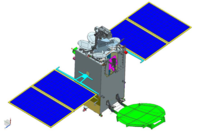GSAT-7A
 | |
| Mission type | Communications |
|---|---|
| Operator | Indian Air Force Indian Army[1] |
| COSPAR ID | {{#property:P247}} |
| Mission duration | Planned: 8 years Elapsed: 5 years, 1 month, 14 days |
| Spacecraft properties | |
| Bus | I-2K |
| Manufacturer | ISRO Satellite Centre Space Applications Centre |
| Launch mass | 2,250 kilograms (4,960 lb) |
| Power | 3.3 kilowatts[2] |
| Start of mission | |
| Launch date | 19 December 2018 10:40 UTC[3] |
| Rocket | GSLV Mk.II F11 |
| Launch site | Satish Dhawan SLP |
| Contractor | ISRO |
| Orbital parameters | |
| Reference system | Geocentric |
| Regime | Geostationary |
| Slot | 63°E[4] |
| Transponders | |
| Band | Ku band |
| Coverage area | India |
GSAT-7A is an advanced military communications satellite meant primarily for the Indian Air Force with Indian Army using 30% of capacity.[5]
Overview[edit]
GSAT-7A allows IAF to interlink different ground radar stations, ground airbase, aircraft to aircraft Real-time Control System, Airborne early warning and control (AWACS) aircraft such as Beriev A-50 Phalcon and DRDO AEW&CS. The satellite enhances Network-centric warfare capabilities of the Indian Air Force and its global operations.[6][7] The satellite is also used by Indian Army's Aviation Corps for real-time control and communication of its aviation operations.[1][8][9] India is in the process of acquiring high-altitude and long endurance satellite-controlled UAVs, such as American armed Predator-B or Sea Guardian drones, that can fire at enemy targets from long distances.[7]
As of December 2018, there are 320 dual use or dedicated military satellite in the sky, half of which are owned by the United States, followed by Russia, China and India (14).[7] To boost its network-centric operations, the IAF is also likely to get another satellite GSAT-7C within a few years.[7]
The GSAT-7A, with a mission life of 8 years, is also equipped with the payload of 10 Ku band transponders,[6] which offers several advantages over c-band, such more powerful satellite uplink and downlink signals, smaller antennas, and non-interference of communication signals with terrestrial microwave systems.
- 10 channels in Ku band with switchable frequency for mobile users.
- Four steerable antennas
- One fixed Gregorian Antenna.
Launch[edit]
GSAT-7A weighing 2,250 kilograms (4,960 lb) was successfully launched on 19 December 2018 by GSLV Mk II F11 rocket from Second Launch Pad of Satish Dhawan Space Centre.[13] This three-stage launch vehicle 51 meters tall, has a lift-off mass of about 421 tonnes and indigenously developed cryogenic stage.[6][14]
See also[edit]
- Indian military satellites
- GSAT-7
- GSAT
- Indian National Satellite System
- Integrated Space Cell
- List of Indian satellites
References[edit]
- ↑ 1.0 1.1 "Isro to launch GSAT-7A tomorrow, communication satellite to give more power to forces". Hindustan Times. 18 December 2018. Retrieved 2018-12-18.
- ↑ "GSLV-F11 GSAT-7A Launch Kit". ISRO. Archived from the original on 2018-12-11. Retrieved 2018-12-12.
- ↑ "GSLV-F11 successfully launches GSAT-7A". Retrieved 20 December 2018.
- ↑ "Specifications for 11m Ku‐Band Full Motion Antenna Systems" (PDF). ISRO.gov.in. p. 10. Archived from the original (PDF) on 20 July 2019. Retrieved 20 July 2019.
- ↑ D.s, Madhumathi (2018-12-16). "ISRO's GSAT-7A to add more heft to Air Force". The Hindu. ISSN 0971-751X. Retrieved 2018-12-20.
- ↑ 6.0 6.1 6.2 Chandrayaan-2 on track, 32 missions next year: ISRO, Indian Express, 20 Dec 2018.
- ↑ 7.0 7.1 7.2 7.3 Why Isro's Gsat-7A launch is important for the Indian Air Force, Times of India, 19 Dec 2018.
- ↑ "India's Tech Roadmap Points to Small Sats, Space Weapons". Archived from the original on 2015-01-21.
- ↑ "IAF to induct 214 fifth generation fighter jets". Archived from the original on 2011-10-06.
- ↑ "Space Applications Centre, Annual Report 2014-15" (PDF). SAC. p. 16. Archived from the original (PDF) on 7 July 2017. Retrieved 20 July 2019.
- ↑ "GSLV-F11 successfully launches GSAT-7A". pib.nic.in. Retrieved 2019-07-20.
- ↑ "Department of Space Monthly Summary, September 2018" (PDF). Archived from the original (PDF) on 27 October 2018. Retrieved 19 July 2019.
- ↑ "Customer profile: ISRO GSAT-7/7A Project Director G. Shivanna". Archived from the original on 2015-04-02.
- ↑ Clark, Stephen. "Indian space program closes out year with launch of upgraded GSLV – Spaceflight Now". Retrieved 2018-12-20.

